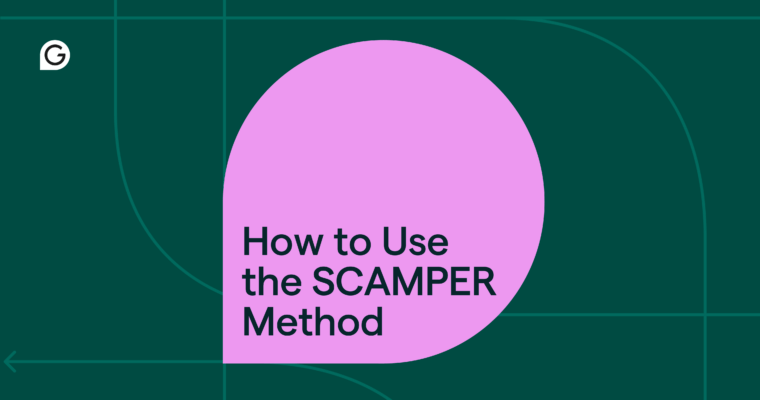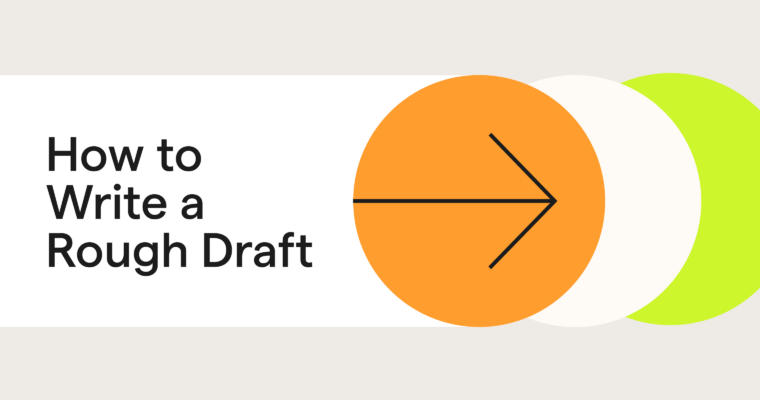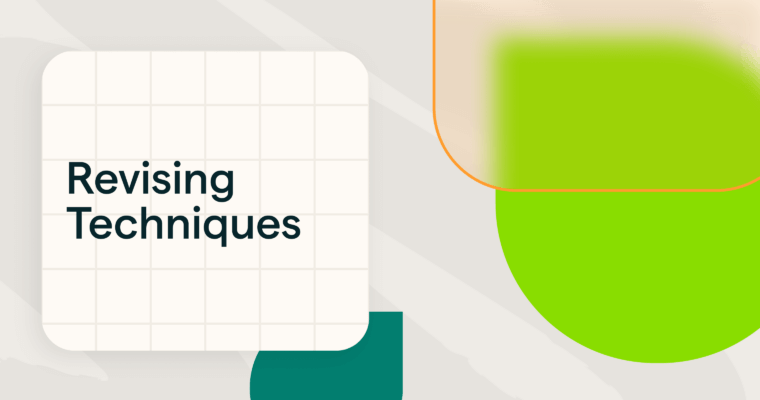
Key takeaways
- SCAMPER is a structured brainstorming method that helps writers generate new ideas by modifying, combining, or reimagining existing ones.
- It stands for Substitute, Combine, Adapt, Modify, Put to another use, Eliminate, and Reverse.
- The method is effective for overcoming creative blocks, refining drafts, and improving clarity.
- Writers can apply SCAMPER to academic papers, marketing content, stories, and more to explore fresh angles and make their work stand out.
Even the most creative writers sometimes run out of inspiration. Whether you are revising a familiar topic, planning a new piece, or stuck midway through a draft, generating new ideas can be difficult. Overcoming writer’s block often requires more than persistence; it calls for a different way of thinking.
That’s where the SCAMPER method comes in. Developed by educator Bob Eberle, this creative technique uses seven simple prompts to help you rethink existing ideas. Instead of starting from scratch, SCAMPER encourages you to explore new directions by modifying what you already have.
This guide explains what SCAMPER is, why it works, and how to use it step by step, complete with writing-focused examples and best practices.
Table of contents
- What is the SCAMPER method?
- What are the benefits of using SCAMPER?
- How to use SCAMPER in practice
- SCAMPER examples
- SCAMPER best practices
- Common mistakes to avoid with SCAMPER
- How Grammarly can help support SCAMPER
- SCAMPER method FAQs
What is the SCAMPER method?
The SCAMPER method is a creative brainstorming method that helps you generate new ideas by reworking old ones. Each letter in SCAMPER represents a prompt: Substitute, Combine, Adapt, Modify, Put to another use, Eliminate, and Reverse. These seven actions help you challenge assumptions, find alternative solutions, and reshape ideas into something more original.
SCAMPER was developed in the 1970s as an educational exercise to help students think creatively, but it quickly found uses in business, design, and writing. Unlike freeform brainstorming or mind mapping, SCAMPER creates a structure you can use to craft an outline. It encourages creative thinking through targeted questions, making it especially helpful when revising or developing an existing idea.
It is also one of many valuable prewriting techniques that can help shape your ideas before you start writing your first draft.
The seven prompts of SCAMPER
Each prompt offers a new way to think about your work. Imagine you are revising a résumé bullet point that currently reads:
“Managed project timelines and ensured deadlines were met.”
Here’s how you could improve it through the SCAMPER method:
1. Substitute
Replace words or structures with stronger alternatives.
Ask: What could make this more specific or results-driven?
Example: Replace “managed” with “led” and refocus the action to emphasize deliverables: “Led cross-functional teams to deliver projects on time.”
2. Combine
Merge ideas or accomplishments to show greater impact.
Ask: Can I combine this with another point to highlight results?
Example: “Led teams to deliver 12 projects on time and under budget.”
3. Adapt
Borrow from other contexts or models.
Ask: How do others describe similar achievements?
Example: “Drove Agile delivery for client-facing initiatives, aligning goals with priorities.”
4. Modify
Change emphasis, scope, or structure.
Ask: Can I make this more concise or more detailed?
Example: “Oversaw schedules for five IT projects across multiple departments.”
5. Put to another use
Repurpose your work for a different goal or audience.
Ask: How could this idea apply elsewhere?
Example: “Streamlined workflows to improve team efficiency.”
6. Eliminate
Remove unnecessary words or sections.
Ask: What can I cut without losing the meaning of my writing?
Example: “Managed projects for cross-functional teams.”
7. Reverse
Flip the order or focus.
Ask: What happens if I start with the outcome?
Example: “Delivered projects on time by managing complex timelines.”
This simple example shows how each SCAMPER prompt helps reimagine the same idea from different angles. It doesn’t necessarily mean that each angle is a better choice than your original writing; it pushes you to see what happens when you frame it differently.
What are the benefits of using SCAMPER?
SCAMPER benefits anyone who writes, plans, or problem-solves for a living. It makes creativity practical and repeatable, helping you find fresh approaches to familiar work. To be more specific, SCAMPER benefits your writing in the following ways:
Encourages new angles
SCAMPER breaks habitual thinking by prompting you to consider ideas from multiple perspectives. Instead of rewriting the same blog post structure, you might combine two formats or reverse the order to create a stronger narrative. Learning how to brainstorm effectively becomes easier with structured prompts.
Works across writing types
You can use SCAMPER in marketing, research, storytelling, or UX writing. A content designer might eliminate extra steps in onboarding text, while a student might adapt a framework from another subject to strengthen an essay.
Improves incomplete ideas
SCAMPER is ideal for revising or expanding existing concepts. During editing, you might substitute a weak headline with something more dynamic or modify a paragraph to fit a new tone.
Supports solo or collaborative brainstorming
You can use SCAMPER alone or with others. A team might use it to rework a campaign concept, while an individual writer might use it to refine a draft. In both cases, it creates a structure for clear, balanced creative thinking.
How to use SCAMPER in practice
You can use SCAMPER anytime you need fresh ideas. Follow these four steps to make the most of your SCAMPER session:
1. Set up your session
Start with a clear creative challenge or writing problem. Ask a specific question, like “How can I make this opening more engaging?” or “How might I revise this article for a new audience?” Write your question at the top of your document or whiteboard to stay focused.
2. Generate ideas across all seven prompts
Move through each letter of SCAMPER one by one. Focus on idea quantity over perfection. This means letting your ideas flow freely and capturing everything that comes to mind. Brainstorming tools can help structure your SCAMPER session.
Take a look at these examples of ideas that could come out of a SCAMPER session:
- Substitute an anecdote with a surprising statistic, or eliminate filler to strengthen a weak introduction.
- To improve a dull product description, try combining the benefits into one line or give them another use by turning them into social media content.
3. Evaluate and refine your best ideas
Once you have a list of ideas, narrow it down. Cluster similar ideas and choose the ones that best fit your goals for the work. Merge complementary concepts to get the most out of them.
Example: Combine a new headline from Adapt with a restructured section from Modify.
4. Repeat and reflect
SCAMPER works best when it’s iterative. After your first round, revisit promising ideas with new prompts. In other words, SCAMPER your SCAMPER results.
Example: If your first round focused on Substitute and Combine, run another using Reverse and Adapt.
SCAMPER examples
Here are three realistic ways you can apply SCAMPER as a writer:
Academic writing
Scenario: A student is improving an essay about how high school students can benefit from online learning.
- Substitute: Refocus the thesis from “convenience” to “accessibility.” The thesis statement might go from “Online learning is convenient for high schoolers, who often have busy schedules” to “Online learning makes school more accessible to high schoolers who have busy schedules.”
- Adapt: Borrow a structure from an educational research paper to include case studies. This could mean writing a five-paragraph essay that analyzes the findings from three separate case studies in its body paragraphs.
- Eliminate: Cut repetitive background information. The writer might eliminate any discussions of hobbies and sports, creating more space in the paper to explore how online learning allows students to work at their own pace.
Result: A clearer, evidence-based argument with a sharper focus.
Professional writing
Scenario: A content strategist revises a landing page to speak to a specific customer avatar, rather than the general public.
- Combine: Merge testimonials and FAQs to increase credibility. The most effective testimonials answer questions readers likely have.
- Put to another use: Repurpose page copy for an email campaign. The benefits listed on the landing page are strong selling points; turning them into emails takes the message further.
- Modify: Simplify the layout for better readability. The strategist breaks large sections into smaller paragraphs, adds headers, and includes callout boxes.
Result: A stronger, user-friendly message that converts better.
Creative writing
Scenario: A fiction writer outlines a short story that feels predictable. She doesn’t want to abandon the idea, so she explores ways to make the plot more suspenseful.
- Reverse: Change the ending to surprise readers. What if the opposite of the original ending happened?
- Eliminate: Remove an unnecessary character. By streamlining the cast, the writer can develop the key characters further. This makes the characters feel more relatable, allowing readers to connect with them more easily.
- Adapt: Set a traditional tale in a modern context. This forces the writer to consider how modern sensibilities and technology would alter the original story’s plot points and ending.
Result: A tighter, more engaging narrative that feels original.
SCAMPER best practices
- Use every prompt. Each one offers a unique angle on your work.
- Write everything down. Even impractical ideas can spark better ones later.
- Separate brainstorming from editing. Generate first, revise later.
- Repeat the process. A second SCAMPER round often leads to stronger insights.
- Tailor it to your task. Adapt prompts for different stages of writing.
- Collaborate when possible. Different perspectives make sessions more productive.
SCAMPER works best when you have some content to work with. This could be notes from a brainstorming session, an outline, or a rough draft. Aim to improve what you already have rather than deleting it and starting from scratch.
Common mistakes to avoid with SCAMPER
- Treating it as a checklist. The prompts are flexible, not fixed.
- Overusing one prompt. Variety encourages deeper thinking.
- Stopping at the first idea. Push beyond obvious answers.
- Editing too early. Evaluate after brainstorming, not during.
- Forgetting to document. Write down every idea.
- Skipping repeat rounds. Revisiting SCAMPER after a break can reveal new insights.
If SCAMPER has you writing in circles or feeling boxed in, you’re doing it wrong. Try a different method or pivot to writing, then back to SCAMPER to edit what you’ve written. SCAMPER should always be helpful, so if it’s not helping you in the moment, there’s nothing wrong with trying a different approach and coming back to it later.
How Grammarly can help support SCAMPER
Brainstorming is one of the most effective ways to unlock creativity, and Grammarly can make your SCAMPER sessions even more productive.
- Use Grammarly’s AI tools to organize your ideas and refine tone while drafting.
- Expert Review identifies unclear logic, while Reader Reactions helps you test your message with different audiences.
- After your SCAMPER session, Grammarly helps turn inspired ideas into clear, polished writing that communicates your message with purpose and impact.
SCAMPER method FAQs
What is the purpose of the SCAMPER method?
SCAMPER helps writers and creators rethink existing ideas and generate new ones using seven structured prompts.
When should I use SCAMPER in writing?
Use it during brainstorming, outlining, or revision. Anytime you want to strengthen an idea or explore creative alternatives, SCAMPER is a helpful strategy.
Can I use SCAMPER alone?
Yes. It is equally effective for solo ideation or group brainstorming.
How is SCAMPER different from mind mapping?
Mind mapping explores associations, while SCAMPER focuses on transforming ideas through structured prompts.
Can SCAMPER work with AI tools?
Yes. It pairs well with Grammarly, which helps refine, organize, and test ideas created through SCAMPER.






